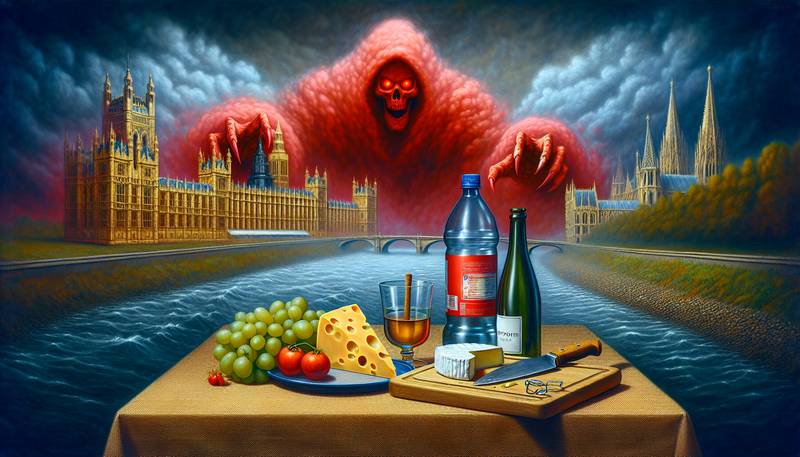BPA Levels in Europe: Concerns Over Food Packaging and Consumer Safety

The Great European BPA FreakoutHold on to your can openers, folks. There's a brilliant new menace on the horizon, and it's lurking in a plastic bottle near you. It's been dubbed the "hormone mimic" or "endocrine disruptor" by the so-called experts, and it's called Bisphenol A (BPA).Now, one might think that Europe – the cradle of civilization, the land of fine wine, and fragrant cheese – would be safe from this chemical scourge. But lo and behold, the nefarious BPA has infiltrated this realm of culinary delights, posing a danger to the very fabric of European society and its unsuspecting consumers.A Chemical Chameleon: Bisphenol A in DisguiseBPA is a sneaky little beast, a master of deception. It hides in plain sight, masquerading as a harmless component of everyday objects like baby bottles, water coolers, and microwaveable dishes. But don't be fooled, dear friends. These seemingly innocuous products are in fact Trojan Horses, concealing a chemical cocktail that's eager to wreak havoc on our unsuspecting bodies.The science nerds tell us that BPA is a synthetic chemical compound, which, when ingested, can interfere with our body's natural hormones, leading to a whole host of nasty health issues, such as heart disease, obesity, and cancer. But of course, this is all based on laboratory experiments with rats and fish, so who knows what this chemical chimera is truly capable of?The European Union's Feeble ResponseNow, you'd think that the mighty European Union, with its vast regulatory powers and commitment to consumer safety, would have the situation well in hand. But alas, much like the fabled Icarus, they have flown too close to the sun of bureaucracy and crashed headlong into the sea of ineptitude.In their infinite wisdom, the EU has regulated BPA for use in baby bottles, but has left the door wide open for this chemical menace to infiltrate other areas of our lives. Food packaging, for instance, is a veritable playground for BPA, as it's often used to make the epoxy resins that coat the insides of cans, preserving our beans, soups, and other assorted gastronomic delights.While the European Food Safety Authority (EFSA) has established a "safe" level of exposure to BPA, recent studies have shown that even these supposedly "safe" levels can still cause adverse health effects in rodents. So, the question remains: where is the line between acceptable BPA exposure and impending doom?Practical Advice for Dodging the BPA BulletWhile the powers-that-be dither and dawdle, it's up to us, the humble consumers, to protect ourselves from the insidious threat of BPA. Here's a handy guide to help you navigate the treacherous waters of European food packaging and emerge unscathed:- Steer clear of canned goods: While not all cans are coated with BPA, it's best to err on the side of caution and avoid these potential ticking time bombs. Opt for fresh, frozen, or glass-packaged foods instead.
- Watch out for the recycling code: If you must purchase plastic products (though I'd advise against it), steer clear of those with the recycling code "7" or "3." These codes indicate that BPA may be present in the material.
- Buy BPA-free products: Though they may be few and far between, some forward-thinking companies have taken it upon themselves to produce BPA-free products. Seek these out, and patronize them to encourage the demise of BPA's reign of terror.
- Microwave with caution: BPA can potentially leach from plastic containers into your food when heated. As such, it's best to heat your food in glass or ceramic containers.
- Don't forget about receipts: BPA has even infiltrated our financial transactions, as many store receipts are coated with the stuff. Handle these with care, and wash your hands thoroughly after touching them.
A Future Free of BPA?True, the threat of BPA looms large, but there's hope yet for a future free of its insidious influence. In recent years, BPA's ugly mug has been exposed in the public eye, leading to increased scrutiny and demands for safer alternatives. Some intrepid companies have already taken steps to banish BPA from their products, and we can only hope that more will follow suit.In the meantime, it's up to us – the valiant consumers – to take matters into our own hands and protect ourselves from this chemical scourge. No more will we be held hostage by the nefarious whims of BPA. We will rise up, united in our disdain for this toxic terror, and emerge victorious.So grab your glass containers and BPA-free products, and join me in the fight against this chemical menace. Together, we can ensure a safe, delicious future for all of Europe.
|
|







